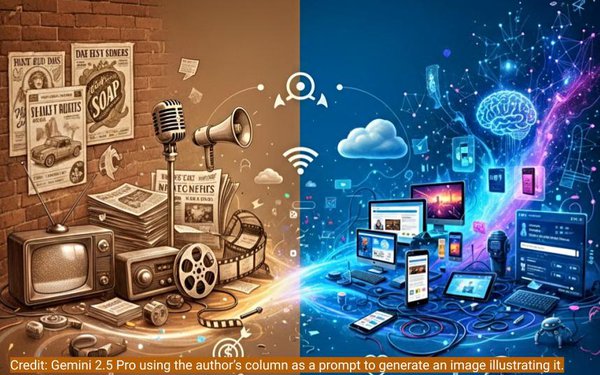
From all my years in research and
consulting, I think I’ve learned a thing or two about marketing worth sharing. Enduring fundamentals, mostly—yet often overlooked. So, over the course of my biweekly column this year, I
want to share some snippets for your consideration. I hope they’re helpful.
This week’s thought: Change is overrated.
Marketers love fads and
fashions. Change is the watchword of marketing. I’m in the trends and futures business, so I’m not unhappy about this. But part of studying trends and futures is knowing when change
matters and when it does not. More often than many marketers realize, change is overrated.
The fundamentals of marketing are unchanging. Brand value propositions are about solving
problems for consumers in meaningfully different ways. Nothing about digital or AI changes that. We can look back and see, too, that nothing about the dot-com era or the invention of bar code scanners
or the rise of super centers and enclosed shopping malls before that or the wiring of America with cable TV or anything else changed the fundamentals of marketing.
advertisement
advertisement
Over time,
researchers get better tools to study, test and track marketing ideas and execution. And marketers get new ways of engaging consumers, delivering ads and capturing attention. But the fundamental job
of marketing is unchanged—deliver a solution in a unique, relevant and affordable way.
This is not to dismiss change. Indeed, improved research tools and new media and retails
channels are big changes. They matter a lot. But they matter because of the fundamentals. These are changes to do a better job of delivering what’s unchanging. The irony of marketing is that the
value of change is measured by what’s unchanging.
I realize that this sounds like quibbling over words, but this ties directly to the paradox of consumers—people are both
averse to and welcoming of change.
On the one hand, change is stressful. Consumers must learn new habits and new routines and absorb new information and new options. It is often
expensive and confusing. Unsurprisingly, people often prefer not to change, even when change is for the better.
On the other hand, change can be exciting and entertaining. Novelty is
enticing and freshening up adds allure, particularly when it signals status, style or sophistication. Greater convenience, more value and higher quality are attractive, even when they come at some
cost of time or money.
Marketers are constantly trying to strike a balance between welcome and unwelcome change. This is not easy because the tenor of marketing is one of change.
Marketers are surrounded by a heady churn of innovation, test-and-learn, modernization, future focus and acceleration. Which makes marketers prone to overrating change.
It also makes
marketers prey to suspect claims about change. My pet peeve is the stat made famous in a 1997 Morgan Stanley report—the purportedly shrinking time it takes new technologies to reach 50 million
users. As ISP pioneer Gisle Hannemyr subsequently proved in an underappreciated analysis, this contrast of radio, TV and the internet was mistaken. It
captured the moment, though, thereby escaping any real-time scrutiny. Marketing is wont to celebrate change even when none is in evidence.
This carries through to consumers. We think
that consumers like change as much as we do. So, we flood the market with more change than it can bear, undeterred by the unchanging evidence that most new products fail and that most new ads go
unseen or are soon forgotten.
Change for the sake of change is built into modern marketing. In the mid-1920s, General Motors President & CEO Alfred Sloan introduced annual
model-year design changes, an idea he borrowed from the bicycle industry. The auto category was approaching a saturation point for penetration, so something was needed to stimulate turnover and repeat
buying. Eventually, Sloan’s concept went from new designs to shorter lifecycles and planned obsolescence became a central design principle.
Consumers buy into such novelty, but
not always. Perhaps the clearest example of this is New Coke. Coke management felt that the product needed freshening to stay competitive. Consumers felt otherwise.
When something is
always at hand, like Coke, people tend to take it for granted. This is easily mis-read by marketers as time for a change. But when something as iconic as Coke is abruptly taken away it becomes
noticeable by its absence. For things with deep cultural connections, like old Coke, what people notice most is how fondly they remember it. In such cases, people want to get back what they have lost,
which reinvigorates the old to the detriment of the new. This is what happened, and the irony is that New Coke, as hoped, reinvigorated Coke sales, but by its failure not by its success.
New Coke is also a reminder that old habits are hard to break. But not impossible. The question is whether new habits will last. It is a lot easier to get consumers to try something new than
it is to get them to stick with it. It is even harder when consumers are forced to do change out of necessity rather than being incentivized or compensated for it. Consumers will slip back into old
routines very quickly unless the effort involved in changing is well-rewarded with a higher quality product or experience.
Change can be incremental, thus slow to catch on. But
sometimes, change happens all at once. This is how big marketplace disruptions clear the way for emerging trends and burgeoning brands to accelerate into an enduring mainstream position. Disruptions
that challenge existing business models are the sorts of change that upend the marketplace. Otherwise, change is a hard sell for consumers.
Change is important and should not be
ignored or foregone. All too often, though, change is overrated.